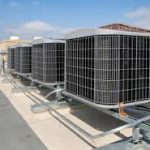As part of every installation, CMRVA heating and air conditioning technicians follow a comprehensive set of procedures to ensure that your system is properly connected and functioning at optimal levels.
- Procedure: ALWAYS purge nitrogen through the copper tubing and coil while performing welding procedures.
- Purpose: To ensure maximum refrigerant flow by eliminating contaminating carbon build-up during the welding process.
- Procedure: EVACUATE system with service caps in place and secure to prevent air and moisture from entering the system.
- Purpose: To remove all moisture, which prevents rapid to premature compressor failure.
- Procedure: LEAK TEST with nitrogen after welding is completed (Fill system to 150 psig with nitrogen and hold).
- Purpose: To prevent future service calls, reduced capacity and longer lifespan by having a refrigerant system that is leak free. Any system operating with an insufficient amount of refrigerant due to any size leak causes higher electric consumption, decreased capacity and shorter lifespan of the equipment.
- Procedure: EVACUATE system to 400 microns or less with a digitally calibrated micron gauge and use a 4-Valve Manifold gauge set, so that you can isolate your micron reading from the pump.
- Purpose: A proper vacuum guarantees a dehydrated system, as well as a leak-free refrigerant line system. Dehydration prevents any acid buildup that will lead to future compressor failure.
- Procedure: Whenever possible we will ALWAYS use new refrigerant lines on every installation. (There are no special cases to this rule)!
- Purpose: Any refrigerant line system that has been used by a previous system has some type of contamination in the lines. This contamination will lead to blockages and restrictions which may cause premature failure of the system. Replacing the lineset is our first choice every time however there are times in the field when line replacement is not permitted by constraints of the construction of the home or the community itself. When this occurs there is a procedure that can be performed that allows the existing lineset to be flushed per manufactures standards and reused. Proper flushing will help protect your new system from contaminant harm.
- Procedure: EVACUATE every new system with NEW OIL every time.
- Purpose: Once the oil in a vacuum is used, the oil becomes fully saturated with moisture. The proper vacuum level required is not achievable when reusing this oil.
- Procedure: ALWAYS use separate manifold gauges for R-410A and R-22 systems. DO NOT USE combination gauges for R-410A and R-22.
- Purpose: The mixing of different refrigerants is similar to using different blood types. It doesn’t’ work.
- Procedure: ALWAYS cut copper tubing with a sharp wheel and carefully ream out inside while tilting tubing down to prevent shavings from entering.
- Purpose: Any foreign body in the refrigerant line system can cause restrictions that could lead to decreased capacity and/or equipment failure.
- Procedure: ALWAYS introduce refrigerant VAPOR into the line set and indoor coil to break vacuum and STOP at 25 psig pressure. Then remove service valve caps to open system. DO NOT remove service caps while system is in a vacuum.
- Purpose: The state of the refrigerant system needs to be changed from a negative to a positive pressure to be sure that no outside air enters the system upon start up.
- Procedure: ALWAYS check and set proper air flow on indoor unit to match required system air flow (Example: Variable Speed switches).
- Purpose: Improper air flow setting will not allow a system to charge correctly nor gas pressure set accurately to achieve a proper temperature drop/rise. It is one of the most important parts of the start-up.
- Procedure: UTILIZE manufacturer’s literature and information to properly set charge on system. (Fill out essential readings paper work).
- Purpose: Proper operation of the equipment guarantees the lowest possible energy costs and maximum performance.
- Procedure: ALWAYS STAGE all electric backup heat packages on every system that has a heat package of 15 kw and higher.
- Purpose: The most economical and comfortable way to utilize electric backup heat is the staging of the heating elements. This procedure allows you to use only what you need, which in turn saves you hundreds of dollars.
- Procedure: ALWAYS use a digital/programmable thermostat control center.
- Purpose: Maintaining the proper comfort levels within a home is best accomplished by utilizing a control center that monitors staging of the heating/cooling, humidification, dehumidification, filter change reminders, as well as flexible times for setback saving.
Quality Installations Begin With Training
You can be confident that the CMRVA technician who installs your heating and air conditioning system knows his stuff inside and out.
CMRVA is the only heating and air conditioning company in the Virgina area with its own in-house heating and air conditioning training facility. In our facility, we have 11 pieces of working equipment to keep our technicians up-to-date on the newest technologies and proper installation standards.
All CMRVA installation and service technicians attend weekly classes, taught by our own N.A.T. E. certified trainer.
Our ongoing training program includes:
- Hands-on training with actual working equipment to improve skill levels
- Quarterly technical testing of all field personnel
- Over 150 hours of training yearly
Every CMRVA technician goes through this rigorous training to ensure that your new heating or air conditioning system is installed correctly.
https://cmrva.com/services/heating-system-installation/


